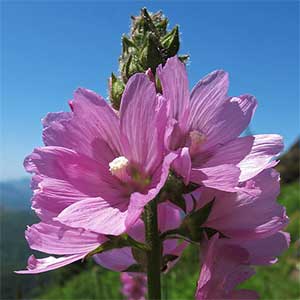Sidalcea hirtipes
Sidalcea celata
bluff mallow, bristly-stem checker-mallow, bristly-stem checkerbloom, hairy-stem checkermallow
dwarf checkerbloom, Redding checkerbloom
several, scattered, erect, arising from rhizome apices, usually slightly hollow, densely, harshly bristly-hirsute, hairs stiff, pustular, simple, forked, or stellate, often 2–2.5 mm.
mostly single, usually erect, sometimes branched distally, solid (sometimes hollow in older, robust plants), sometimes glaucous, proximally densely bristly-hairy, hairs reflexed, stiff, simple, sometimes also coarse, 2–3-rayed, stellate, 1–1.6(–2.5) mm, pustulate, sparser distally, with minute, stellate hairs in inflorescence.
basal and cauline;
stipules linear-subulate, 6–8 × 1–1.5 mm;
petioles of proximal leaves 20–30 cm, 3 times as long as blades, reduced distally to 1/2 times as long as blades;
blades: basal and proximalmost orbiculate to reniform, shallowly 5–9-lobed, 10–15 × 10–15 cm, thick, base narrowly cordate, lobe margins coarsely crenate-dentate, apex rounded, surfaces coarsely hirsute, hairs stiff;
distal orbiculate, deeply palmately 5–7-lobed, incised ± to base, lobes sometimes lobed again, base cuneate, apex acute, deeply 2–3-toothed, surfaces long-hirsute or with 2–4-rayed, stellate hairs abaxially.
mostly basal, some cauline;
stipules usually early-deciduous, linear-lanceolate, 3–7 × 1 mm;
proximal petioles 15–18 cm, 3–4 times as long as blade, distal usually to 1/2 times to as long as blade;
blades: basal rounded, usually palmately 7-lobed, shallowly incised, 4–8 × 4–8 cm, lobes 1.5–2 cm wide, margins crenate-dentate, 3–7-toothed, apices obtuse;
distal 3–10, palmately 5-lobed, deeply incised, 2–6 × 2–6 cm, lobes narrow, linear, 2–3.5 × 2–4 mm, margins entire or 1–5-toothed, surfaces: abaxial stellate-hairy, hairs 6-rayed, 1.5 mm, adaxial hairy, hairs simple, 1.5 mm, distalmost glabrate adaxially and sometimes simple-hairy.
erect, spiciform to subcapitate, dense, calyces usually conspicuously overlapping in flower and sometimes in fruit, proximals usually long-pedunculate, unbranched or branched, 20+-flowered, 10+ flowers usually open on spike at same time, not interrupted, not 1-sided, usually to 8 cm, usually not elongate but sometimes slightly elongated in some populations and to 20 cm in fruit;
bracts paired or single, linear, distal undivided, proximal distinct to base, 6 mm, mostly slightly longer than pedicels.
erect, open, calyces not conspicuously overlapping except sometimes in bud, unbranched or branched, (5–)10–12(–23)-flowered, elongate, sometimes 1-sided, 10–40 cm;
bracts lanceolate, usually undivided, 3–4 mm, shorter than pedicels and calyx.
1–3(–5) mm;
involucellar bractlets absent.
(3–)5–10(–15) mm;
involucellar bractlets absent.
bisexual or unisexual and pistillate, plants gynodioecious;
calyx often purple tinted, 9–11 mm, to 11–16 mm in fruit, margins ciliate, hairs 1–2 mm, surfaces finely stellate-hairy at base and with coarser, longer, simple and stellate hairs apically;
petals usually pale pink to rose-lavender, rarely white, slightly or not pale-veined, (9–)10–21 mm, pistillate often 9–14 mm;
staminal column 5–7(–10) mm, hairy;
anthers white;
stigmas 5–10.
usually bisexual, infrequently unisexual and pistillate, plants gynodioecious;
calyx (7–)9–10 mm, to 12–14 mm in fruit, densely stellate-puberulent;
petals pale pinkish lavender, often pale-veined especially when dry, pistillate 10–20 mm, bisexual 20–25(–31) mm;
staminal column 7–8(–10) mm, sparsely puberulent;
anthers white;
stigmas (6)7(8).
2.5–3.5 mm.
2.5 mm.
7–8 mm diam.;
mericarps 5–10, 3.5–4 mm, glabrous or sparsely stellate-puberulent, roughened, prominently reticulate-veined, sides rugose and pitted, back less so, mucro 0.6–0.8 mm.
6–8 mm diam.;
mericarps (6)7(8), 3–4 mm, minutely glandularpuberulent, glabrescent, margins sometimes sharpedged, roughened, strongly reticulate-veined, sides and back deeply pitted, honeycomblike, median line on back but not furrowed, mucro 1 mm.
= 60.
= 60.
Sidalcea hirtipes
Sidalcea celata
Of conservation concern.
Sidalcea hirtipes is uncommon and known from Clatsop, Lincoln, and Tillamook counties in Oregon and Clark, Lewis, and Wahkiakum counties in Washington. Its elevation and habitat vary, and it seems as much at home on steep coastal cliffs as in more inland, historic prairies and mountain meadows. Populations can appear to be large because of the long-rhizomatous and clonal nature of the plants; they are few and local. It is threatened by grazing, loss of habitat, fire suppression, road construction and maintenance, and changes in hydrology. It is a candidate for listing in Oregon and has been listed as endangered in Washington. Sidalcea hirtipes is characterized by its coarse indument of bristle hairs, its generally compact spikelike inflorescences, its relatively few, large, erect, hirsute leaves, and, especially, its extensive, coarse rhizomes. The inflorescences in some populations are elongated in fruit; its range, hirsute indument, and thick leaves along with coarse rhizomes help to distinguish it from other species. Stem internode length varies depending on habitat, as in many other Sidalcea. Molecular data suggest a relationship among S. hirtipes and S. asprella, S. celata, and S. gigantea (K. Andreasen and B. G. Baldwin 2003).
(Discussion copyrighted by Flora of North America; reprinted with permission.)
Sidalcea celata has been recognized as a local species endemic to Shasta and Tehama counties (especially near Redding) in the northern inner North Coast Ranges; it was previously included within S. malviflora. Hitchcock’s concept of S. celata as a subspecies was broader and included plants from additional counties that do not match the type very well; most have been re-identified as S. asprella or S. oregana. Sidalcea celata has been confused with S. asprella, S. gigantea, and S. robusta and appears to be variable. Its narrow distribution, preference for serpentine, typical lack of elongated rhizomes, basally retrorsely hirsute stems, presence of basal leaves, and relatively large bisexual flowers and fruits are distinctive.
(Discussion copyrighted by Flora of North America; reprinted with permission.)


